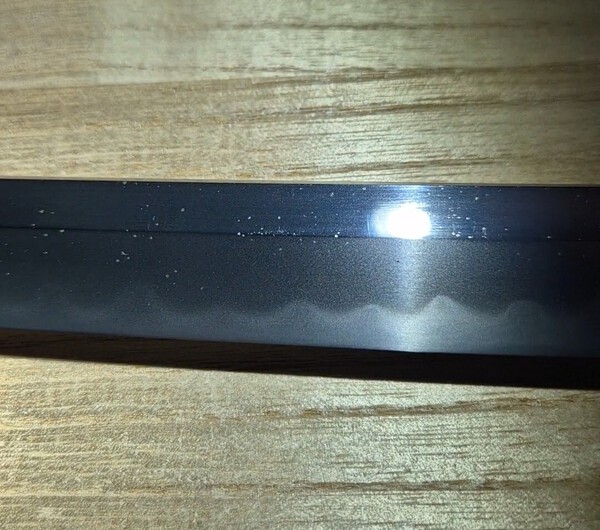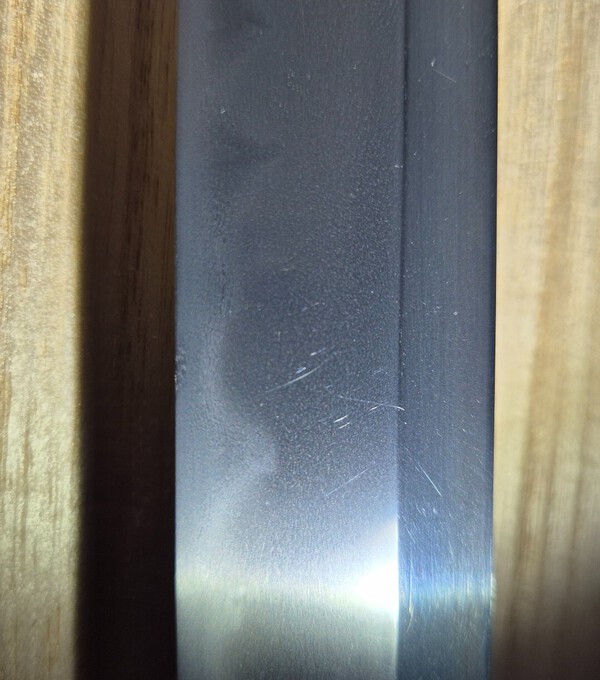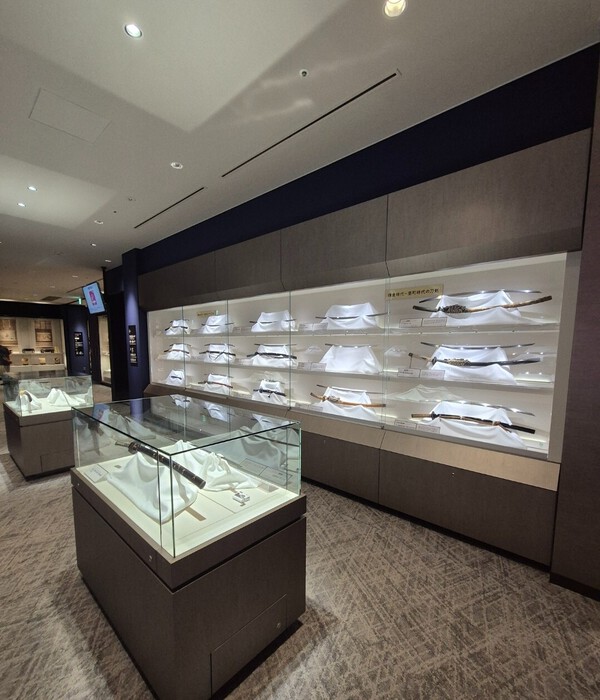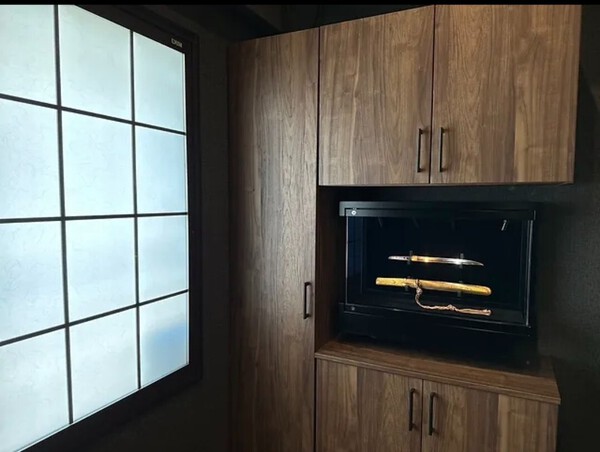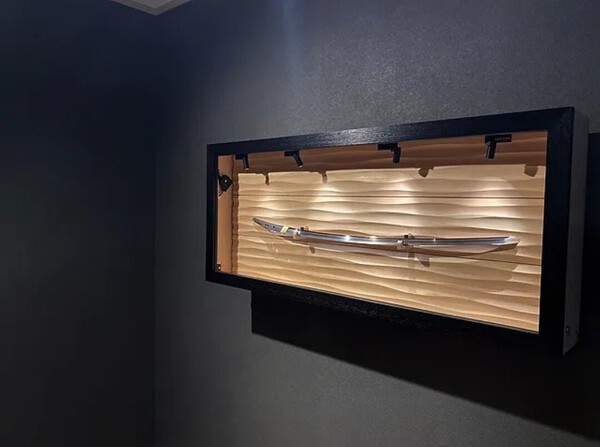-
Posts
95 -
Joined
-
Last visited
-
Days Won
1
Content Type
Profiles
Forums
Events
Store
Downloads
Gallery
Everything posted by Emil
-
Upon closer examination of a katana I recently gifted my father, I see small dots along the blade. 2 months ago, when it first arrived with at my brother’s, he sent me pictures of it. I saw the small grey dots but assumed it was just dust. So it doesn't appear to have worsened in the last two months. Mostly they the spots go unnoticed, but I can see that they have a yellowish tone if I look really close in some light conditions. I advised my dad to keep it well oiled at all times. However, every time it's pulled from the shirasaya there are small wooden flakes on the blade. It's probably been stored in this shirasaya for many years already, judging from the aged look of it. What is my best course of action to prevent further oxidation? What would you have done in regards to blade and shirasya? Now that this licensed Showato has left Japan and the torokusho has been returned, there are no guarantees that it will pass inspections and be let inside Japan ever again. Let alone the price of a polish, I'm quite concerned that if left as is, it might get worse?
-
Now that I do have the sword in hand, I tried to look at these. I believe I can see the martensite crystals but in some lighting conditions (see my photos) it also looks like a shadow. I'm not confident enough to draw any conclusions
-
After a very long wait, I'm finally able to take my own photos of the sword. I tried to vary the light conditions to capture the hamon's different appearances. I hope these are better to determine if the blade is oil or water quenched? @ROKUJURO are any of these photos good enough? For a Showato, I believe it has a pretty well grained hada and in the sellers own "appraisal" document it's labelled as Nie deki.
-
Wow, thanks guys! This is great information Interesting to read that they dissolved the steel and mixed it with the Japanese steel, that's a rather odd thing to do.
-

Type 19 Project and Historical/Personal Context
Emil replied to Aegon's topic in Military Swords of Japan
Barry is right about this unfortunately. Cedar contains natural oils and resins that may contribute to oxidation over time. These oils could cause slight reactions with high carbon steel blades, particularly if the wood isn’t cured properly. Moreover, it's softer than ideal. While easy to carve, it will dent easily. Look for Japanese magnolia wood (honoki). This wood is soft enough to carve but still durable and free of oils that might promote oxidation. It is also resin free, which helps protect the blade from moisture and rust. Ideally the wood has been seasoned for a few years (traditionally 5-10 years) for dimensional stability and dryness. -
@Bruce Pennington Thank you for sharing! This is probably as close to a fact as we can get on this matter
-

Type 19 Project and Historical/Personal Context
Emil replied to Aegon's topic in Military Swords of Japan
@Aegon I understand where you're coming from because I used to have the same idea when I was new to world of Japanese swords. The thrill of testing a sword’s sharpness and putting it to use can be very tempting when you don't fully understand this art. However, the more I studied and learnt, I realized that using old swords isn’t okay, unless you're living in Japan and have no other choice. These swords, crafted by skilled hands in a different time, were passed down through generations, surviving wars, conflicts, and history itself because of the careful and responsible owners that cared for them. When we use an old or antique sword, we unintentionally serve our own desires at the expense of the sword’s lifespan. Each time a blade is sharpened or struck against a target, we diminish its original integrity. In a way, the sword ends up serving our ego, rather than us being humble stewards of its history. By taking care of these swords, rather than using them, we honor the people who crafted and preserved them before us. Their care is the reason we can enjoy these pieces today. I’ve come to appreciate that my role is not be the final destination of the the swords I aquire, but to preserve them so that future generations can experience their beauty and craftsmanship just as we do now. It's not just about ownership, but stewardship and there's something deeply rewarding in that perspective Frankly speaking, with the abundance of affordable reproduction swords available for iaido and tameshigiri it would be plain careless to use anything historical for that purpose. And I wouldn't be proud to tell anyone of it, as it would only highlight my ignorance On another note, I wish you the best of luck with that tsuka and saya project of yours 👍 -
That's enlightening, thanks for clarifying @Bruce Pennington Then I will leave my belief about a sword shape stamping machine in the past
-

Type 19 Project and Historical/Personal Context
Emil replied to Aegon's topic in Military Swords of Japan
I appreciate your passion for history and your connection to the Type 19 sword, but I wanted to offer some perspective. It can be interesting to draw parallels between personal experiences and historical events, but some of your ideas, like Japan’s actions in WWII being a response to "oath torment" and "Stockholm syndrome," aren't supported by mainstream history. Treaties like the Convention of Kanagawa were unequal, but Japan’s actions were influenced by many complex factors beyond simple coercion. Be careful about projecting psychological concepts (like Stockholm syndrome) onto historical actors and situations where they may not fit. Nations and cultures act in complex ways that can’t be easily likened to individual experiences of trauma. History should be viewed with a broad lens that accounts for the complexities of the time. As for your sword, I’d advise against altering it, especially on the basis of unverified historical hypothesises, that you are likely to find not holding true in the future. Historical artifacts, like swords, carry important cultural significance, and modifying them erases part of that history. Maybe get a sword box 刀桐箱 which can be decorated with hakogaki 箱書き to express your beliefs -
@Bruce Pennington what about the lowest tier from the commonly quoted production methods list? I assumed that one was the only one that could be called "machine made" as it appears at least by this description that it wasn't hammered into shape? "9. Machine made. Serial number in the blade. No forging; stamped out and quenched in oil without differential hardening, assuming that they are hardened at all. No hada and no hamon. Some may in fact be plated, and in the worst cases the hamon may be acid etched onto the steel. The classic example is the NCO swords. On a par with Chinese fakes, and the most commonly faked sword.'
-
I see, maybe it's just a misconception on my end then. I've mainly seen Showato that looks like these pictures below in Japan. I didn't expect the one I linked to have a signature because I thought that was a practice exclusive for higher end Showato
-
I was browsing the swords at Nosyudo when I stumbled onto this Showato labelled as "Heisei" https://nosyudo.jp/b280108362/ I was surprised to see such a crudly made sword with Torokusho. By the sugata and kissaki of this sword I would have said it's its one of the lowest tiers of Showato, if not completely machine made. But it's signed by Kaneyoshi Okada. I just get confused by looking at this sword, maybe it's lack of experience but everything about the blade looks like lowest tier (no geometric yokote, no hamon, machine made bo hi) but then there's a signature on it? I wish to learn and this is confusing to me, can someone explain what kind of Showato this is?
-
Thanks for sharing your perspectives everyone. Obviously we're not going to change anything here but it's been interesting to read your thoughts on the topic.
-
@Benjamin that's really cool, I like how the swords appear to be floating in the display case I've ordered from here in the past, the craftsmanship another level, and the price is good. I recommend using Google chrome as it can tra slate the whole website https://www.katanatansu.jp/
-

Nihonto Recommendations in Kanazawa, Nagoya ?
Emil replied to Kanenaga's topic in General Nihonto Related Discussion
I visited Nagoya just 2 weeks ago, checked out all Nihonto related places I could. My strongest recommendation is The Nagoya Sword Museum, 200 Japanese swords are always on display. There's also Japanese sword collection Room - Marunouchi which has a small museum display. It fades in comparison to the Nagoya Sword Museum, but it's not bad. Sword store - Sanmei Trading has a very nice display of swords that you are free to browse. Pro tip: don't bother the man with questions unless you're buying 😅 You will be quite close to Seki, which has a lot to see as well -
I love his work, really great products But I think it's a bit of a leap to recommend someone working on a IKEA DIY display to order a 2700 USD tabletop display from Japan 😅
-
I've been thinking about this for a while, and today I came across Tsuruta's blog post where he mentioned a similar concern. I wanted to get your perspectives on it: > "Recently, I've noticed that the prices of Japanese swords have risen considerably. Expensive items are being purchased from overseas, and Japanese swords are now being sold as commodities. They have become investment targets. Unfortunately, Japanese swords may become less common in Japan in the future, with many foreigners likely to own them. Foreigners have also increased significantly as traders, and they possess considerable knowledge. Items that were once part of Japanese culture, such as netsuke, woodblock prints, inro, and old coins, have mostly flowed overseas. However, these items are well-preserved abroad, where they are treated with care. Japan's humid climate is not the best environment for preserving Japanese swords. However, Japanese people have always taken great care to maintain their swords. Thanks to the careful management by daimyo (feudal lords) for over a thousand years, the swords have survived without rusting." – Tsuruta's blog, September 2024 In the last decade or so, there's been a surge in international interest in Japanese swords. Reproduction companies are popping up everywhere, and more people than ever are buying Nihonto from Japan. Business is booming for Japanese sword dealers, with rising prices and high demand. The problem is that this trend isn't sustainable. Every year, thousands of antique Nihonto leave Japan, and there's no clear data, but the number of swords returning is just a fraction of what's being exported. At this pace, it seems inevitable that Japan's supply of antique swords will be depleted. Ideally, these swords would go to serious collectors who would care for them and ensure future generations can appreciate them. But even if the first buyer is responsible, without the deep cultural respect for swords ingrained in Japan, there are no guarantees that, after the collector passes, their heirs will recognize the value of the sword. There's a real risk that an NBTHK-certified sword could end up rusting in a garage, or worse. Some tourists buy these swords without any serious commitment to their care. This could be the next "exticinction" of Nihonto, similar to what happened during the American occupation of Japan, only slower and less obvious. Not to mention the obvious problem in the West with Nihonto getting mixed up with reproduction and chinese fakes. How long will it take before the Japanese government reacts to the mass export of their cultural heritage? If I were to propose a solution to sustain the Nihonto market, it would be to make it harder to purchase antiques by establishing some kind of licensing system—only serious collectors would be able to buy them. At the same time, the production restrictions on Shinsakuto should be lifted, allowing smiths to produce more new blades. Most of the lesser serious buyers, like tourists, don’t care if the sword is from the Muromachi period or a Gendaito; they just want a "real" Japanese sword. In fact, just like the American GIs during WWII, tourists often prefer "shiny" swords. That’s why many Americans brought back Showa-to over older swords during the war (p71, Modern Japanese Swords and Swordsmiths, 2002). Right now, at a price range of 500,000 JPY, a tourist can’t buy a new Shinsakuto, so they end up buying lower-quality antiques and wakizashi. These are the first swords to perish in the hands of uneducated or uncommitted owners. By lifting the production cap on new swords, volumes could increase, prices could come down, and tourists would be guided toward new swords. This would allow serious collectors to focus on preserving the antiques. It could also help the Koshirae makers by boosting demand. Google search volume in the category Katana (group of similar search words) Please share your thoughts on the subject, I'd love to hear the your opinions
-
Might be a bit expensive but you can use this as an inspiration https://en.katana-case-shi.com/ https://www.instagra...atana_case_shi_shop/
-
Thank you Jean, I'm learning a lot here. I appreciate you taking the time to explain things for me. This information is not easy to come by, even after reading through several books now, I'm starting to see that the hard, technical facts on showato and its production methods is very scarce.
-
That's alright, I managed to search through all relevant sword books today. Stumbled onto this website today and I can really recommend it, it's a virtual library where you can "borrow" all the sword books you want for free, basically just reading them in your browser without the function to save them. And because they are digitalized you can even search for words and terms like "swedish steel". Great for when you want to conduct quick research on very narrow topics. https://archive.org/
-
That's interesting, it's usually said that even the good tamahagane smiths will lose 10% of their swords in the water quenching process. I've read that oil was a better medium for inexperienced sword makers. I haven't heard your argument that the differencee in steel composition made the showato steel more likely to crack. But it makes sense to me, especially since they had to work on a lot of different steels with different properties all the time
-
@Bruce Pennington this list always gets quoted whenever someone asks about a showato here. Do you know the origins of it? It was my understanding that it came from Fuller? 1. Tamahagane gendaito. Fully hand forged and differentially hardened in the traditional manner using water as a quenching agent. Possesses an active hamon and hada. 2. Mill-steel gendaito. Fully hand forged from mill steel or (more often) 19th century railway tracks made from Swedish steel. Differentially hardened in the traditional manner using water as a quenching agent. Possesses an active hamon and hada. 3. Koa-isshin Mantetsu-to. Made from Manchurian steel by a special process. Partly forged, partly engineered, and differentially hardened in the traditional manner using water as a quenching agent. Possesses an active hamon and hada. 4. Han-tanren abura yaki-ire-to. Partially forged from mill stock, some folding, differentially hardened using oil. Does have a hamon although it is nowhere near as active as a water-quenched sword, but lacks hada. 5. Sunobe abura yaki-ire-to. Drawn down, forged to shape, not folded. Differential hardened using oil, may have a fairly inactive hamon, but no hada. 6. Mantetsu-to. Rolled from Manchurian railway tracks. Differential hardening using oil, may have a fairly inactive hamon, but no hada. 7. Murata-to. Rolled or drawn, oil hardened but not differentially hardened. Yakiba but no visible hamon and no hada. 8. Tai-sabi-ko. Stainless steel, oil-hardened, no grain, no hamon, possible yakiba. Made for the Imperial Japanese Navy to resist salt corrosion. 9. Machine made. Serial number in the blade. No forging; stamped out and quenched in oil without differential hardening, assuming that they are hardened at all. No hada and no hamon. Some may in fact be plated, and in the worst cases the hamon may be acid etched onto the steel. The classic example is the NCO swords. On a par with Chinese fakes, and the most commonly faked sword.
-
Thank you very much for the helpful information @Bruce Pennington that's spot on! Exactly the kind of information I was looking for, I'm so grateful for you taking the time to find that for me, thank you! The two pages you sent from this book, is there more information along those lines? If so, I think I need to order myself a copy of that book I'm very interested in learning more about the whole Showato era related to the sword production.
-
Does anyone have a copy of the book Military Swords of Japan, 1868-194 by Richard Fuller and Ron Gregory? I'm very interested in where the conclusion originated from that mill steel gendaito was "more commonly made of Swedish railroad steel" so any references with more context from the book would be highly appreciated. I can't get my hands on the book myself. (No shipping options) I'm researching a Showato that I have and a lot of my conclusions are pointing toward "Mill-steel gendaito" forged from mill steel (or more often) 19th century railway tracks made from Swedish steel. As often quoted by Fuller and Gregory. Being Swedish that has some extra significance to me and I'm trying not be biased by my hope that it could be. Therefore I'm deep diving into the historical sources, trying to find answers. I find a lot of contradictions in this area of research. This article from Ryujin swords mentions "The best ‘mill steel’ gendaito are made from mid-19th century railway tracks that were manufactured from Swedish steel and exported to Japan" It goes on to say that it was "blister steel" which had uneven carbon distribution and resulted in hada similar to tamahagane. My problem with this is that the Japanese started building their railway in 1872 and ramping up in the following years. This is the time when Bessemer steel started (1868), especially in Sweden with the start of Domnarvet ironworks (1972), focused on railroad production and most of the Japanese railroad would have been built with Bessmer steel, part of it from Sweden as they had 1/5th of the patent and were pioneering the commercialization of the British Bessmer invention. Bessemer steel were of very high quality with even distribution of carbon, which goes against the whole argument of formation of hada similar to tamahagane based on uneven carbon distribution? I'm digging through all English and Swedish sources I can find on the topic of steel exports, Japanese railroad in the 1800s and sword making. If you have any interesting sources, please share it here. ryujinswords-tang-stamps-2017-1218.pdf
-
That's a deep sori! What are they funding? The polishing cost?



